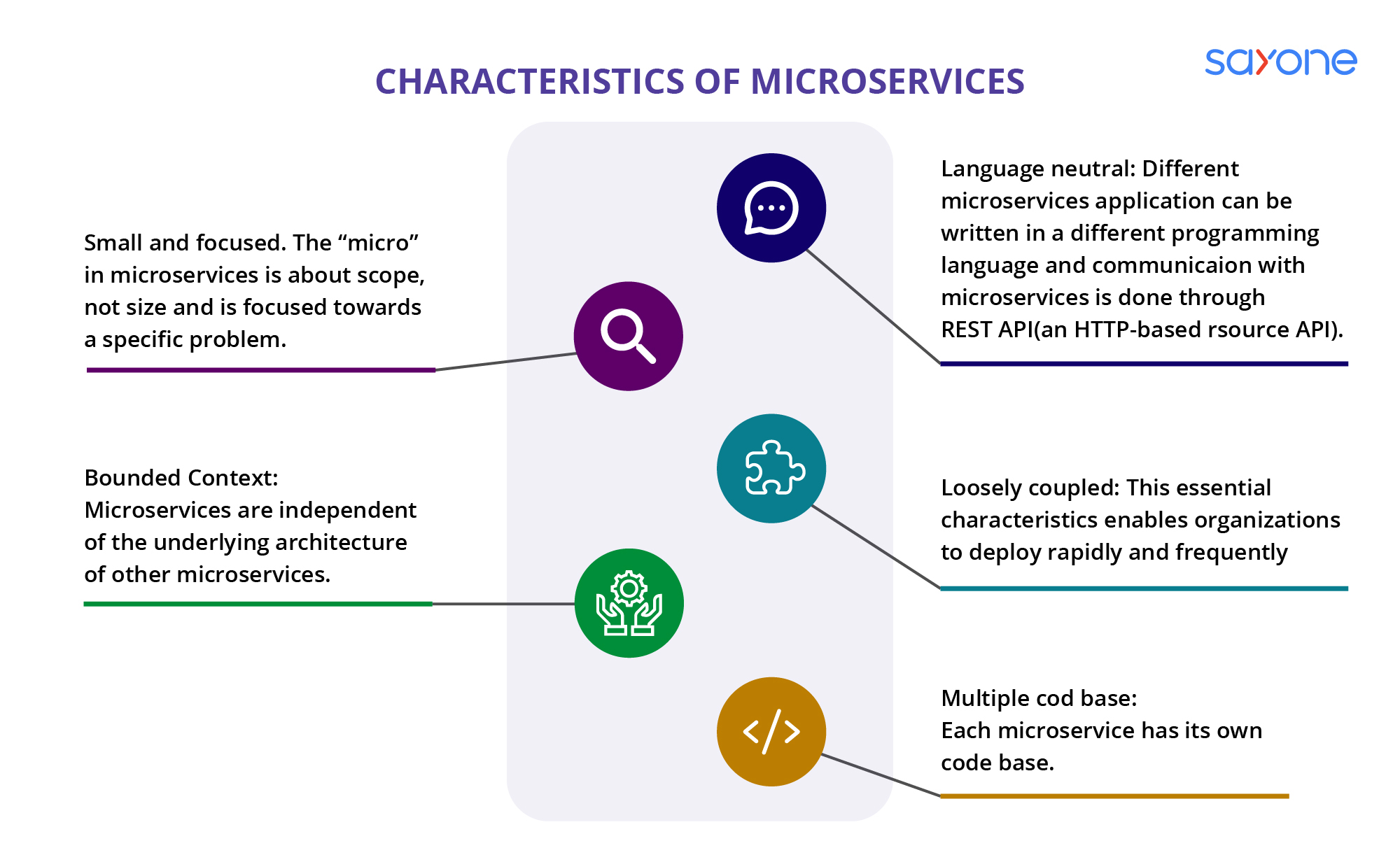
Subscribe to our Blog
We're committed to your privacy. SayOne uses the information you provide to us to contact you about our relevant content, products, and services. check out our privacy policy.

Jomin Johnson November 19, 20218 min read

Generating table of contents...
Microservices are being adopted by most businesses today. The largest brands in the world, including Google, Amazon, and Netflix, have already moved to microservices architecture. Intense competitiveness in the market is forcing others to revamp to microservices in anticipation that these businesses will achieve scalability, flexibility, quality of service, and business success after the transition.
In this article, we attempt to list out the benefits for businesses that come with transitioning to microservices. This may help businesses to identify specific goals and also muster support in terms of the resources that are required to transition into the new system.
In brief, microservices refer to modular formats of services that work independently. When companies move to a containerized structure, there has been incredible growth and success in terms of business value. Given below are some business benefits in more detail:

Constant changes to legacy applications involve high risk, and, at some point, one can easily lose track of the changes. Moreover, the package becomes very difficult to understand for a newcomer. This could negatively affect many other processes. In contrast, loosely coupled microservices allow updates to be set up independently and this process does not affect the rest of the application in any way whatsoever. This leads to quicker application development and upgrade/version rollouts, allowing companies to stick to agile new product development timelines. It therefore aids continuous delivery.
In microservices, because a complete understanding and visibility of network dependencies are continuously required, a deep knowledge of container scanning and cluster networking helps. The fact that consistent access and security for each microservice is required helps one to utilize deep knowledge and apply service mesh in order to ensure that the environment is enjoying top-class security with the help of different tools.
Microservices can be easily scaled horizontally, with two machines running one beside another, instead of opting for a single larger machine. This gives any business the liberty to scale up or down whenever required, say when there is a sudden surge in transactions. This helps the business to save time and money and also provides an improved user experience.
Many businesses revamp to microservices or move to a containerized infrastructure when they expect that their business needs to scale. Automated microservices are simple to replicate, easy to manage, and easier to remove. This allows for a consistent method that can be used for scaling, orchestrating the containers, and managing the business application.
Read our blog “These Tech Giants that became Microservices Architecture companies - And Why You Could Too”
When the application develops problems, only a small piece of the application is affected, not the whole package. For the end-users, this means better performance. Moreover, this eliminates downtime even while the IT department is troubleshooting and restoring the service.
A monolithic application is not adaptable to changes, especially if they are unanticipated. However, in today's ultra-competitive business environment, change is a constant. Therefore, we need a technological environment that can easily adapt to such changes. As a collection of small and independent processes, a microservices-based architecture model is best suited to adapt to these changes that are regularly taking place in today’s disruptive market space.
When you deploy a large application, you may prefer one module of your application to be written in Java while another could be coded in PHP. Various business modules have to be coded differently in different languages depending on their function and on the technology used. In a microservices model, each module is an independent and standalone unit that can be designed according to the parameters that are best-suited. This enables you to work with the latest technologies and what is best for you. It also makes you less dependent on a single vendor.
Kick-start your microservices journey! Give us a call today!
A revamp to microservices future-proofs your business in these days of lightning-quick disruptive changes that keep hitting the market every now and then. With a monolithic application, it is not very easy to bring about any changes. Microservices, being a collection of independent processes, are better suited to adapting quickly to changes in the business environment.
According to statistics, over one-third of businesses have already put together a digital transformation program in place. It is alleged that microservices will play a major role in this transformation by supporting the transformation through agility.
Today’s business environment is one where the time required to produce an application (from the concept stage to the market) is crucial. As latecomers, there is nothing to be gained. However, opting for a microservices-based application allows for the simultaneous, parallel development of more than one module, and this process trims the time to market to a minimum value. You can also quickly deploy any updates to microservices modules rather than to the big monolithic application.
1. Plan: Carefully assess the current system and identify its weaknesses. Determine the desired end-state of the system, and consider any potential business challenges that could affect the process.
2. Design: Use microservices architecture to design the system. Identify the components that will be needed and create a roadmap for the development process.
3. Implement: Use a DevOps approach to implement the system. This will help ensure that the system is built quickly and efficiently, while also allowing for a high degree of flexibility.
4. Test: Test the system thoroughly to ensure that it meets the desired objectives and that it is functioning correctly.
5. Deploy: Deploy the system to the production environment. Monitor the system closely to ensure that it is performing correctly.
6. Monitor: Monitor the system regularly to identify any problems or areas for improvement. Make adjustments as needed to ensure that the system is running smoothly.
Is there a right time to revamp to microservices? The major use-cases when an organization can shift to microservices are as follows:
Large organizations have different requirements and processes. In the event of sudden scope changes, these may have to be remodeled or automated. Monolithic architectures take a lot of time to build, or change and deploy. If you are using microservices, any specific service can be modified and deployed quickly without affecting the scope of any other processes or services. New services can also be built within a short period of time and deployed independently.
Homogeneous monolithic architectures usually employ the same technology to develop their business functionality. This reduces the business scope as every technology has its pros and cons. With microservices, this limitation is reduced as different technologies are used to develop every singular process to deliver the business functionality in the best manner. Therefore, the goals specified for a single process can be easily achieved using microservices.
Many times, a business can save significant amounts of time and money by developing new systems instead of updating existing ones. ROI depends largely on time and deliverability, and businesses may find it more worthwhile to develop new systems instead of having complex systems that are difficult to debug, test, or update.
A revamp to microservices may be expensive for start-ups or businesses that operate on a shoestring budget. However, whatever their disadvantages, the pros seem to outweigh the cons.
At Sayone, we design simple microservices systems without complex architectural layers, and this enables the services to deliver exceptionally fast and enhanced performance. Moreover, our services are significantly decoupled, allowing you to launch independent services. You are not tied down with inter-dependent microservices that work more or less like a monolith.
We design the microservices keeping in mind the margin that is required to transition into the new system. We consider both your organization’s legacy architecture as well as expanding into the cloud system. Our microservices comprise lightweight code, and we provide competitive pricing options for our clients.
Built according to the latest international security guidelines, our microservices ensure the complete safety of all the data. We also deliver the services within the stipulated deadlines and we always assure a quick turnaround time for our clients, knowing the rate at which disruptions are invading the business spaces today. Equipped with the best infrastructure and the latest tools and technologies, our expert developers will provide you with the best microservices that are easily scalable, enabling a good ROI in the shortest period of time.
We can help to manage your move to microservices. Give us a call today!

We're committed to your privacy. SayOne uses the information you provide to us to contact you about our relevant content, products, and services. check out our privacy policy.

About Author
Head of AI-Retail @ SayOne Technologies|Project Manager | Product Owner - CSPO®| Lead Business Analyst

We collaborate with visionary leaders on projects that focus on quality